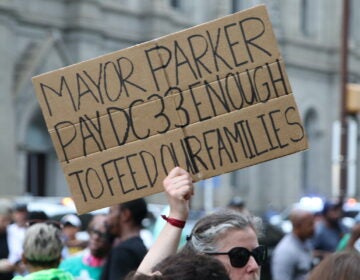Retired environmental engineer from Mount Airy working to mitigate East Germantown flooding
Kelly O’Day is serious about stormwater management. He wants fellow East Mount Airy residents to be, too.
For more than a year, the retired environmental engineer has been researching the city’s sewer system with a close eye on the underground bond between his neighborhood and nearby East Germantown.
The low-lying area’s tendency to flood during heavy rainstorms sparked O’Day’s interest in the exploration. A freak drowning at the intersection of Belfield Avenue and Haines Street last summer catapulted him into public advocacy.
“Most people wouldn’t think they have anything to do with Belfield and Haines,” said O’Day on a recent afternoon while standing by a stormwater drain near his East Durham Street home.
But they do
Whenever it rains, water flows off of rooftops and down into the city’s labyrinth of sewer pipes before dumping into a treatment plant or, during a heavy storm, straight into a nearby waterway — the Delaware or Schuylkill rivers, for example.
In East Mount Airy and sections of adjoining neighborhoods, the water travels directly to East Germantown as it winds its way to the finish line.
During a typical rainstorm, the impact is essentially non-existent.
During a major storm, however, that can quickly change in certain sections of the neighborhood when the system overflows and floods.
On-site explanation
At Haines and Belfield, O’Day points out how each of the intersection’s four feeder streets pitch downward.
The unique, bowl-like topography can be problematic during a heavy storm when a lot of rain drops in a short period of time.
In those instances, the sewer system can quickly fill to capacity and overflow. Similar to other sections of the city, basements may flood as a result. With nowhere to disperse, though, rain water could also potentially collect on the street and spill into people’s houses. It has nowhere to dissipate.
“This is one of the worst places to have a backup,” said O’Day.
When Tropical Storm Lee hit last September, approximately seven inches of rain dropped in an hour, causing several feet to build on the concrete.
The muddy waters from higher ground wreaked havoc on homes, churches and businesses. A 27-year-old woman drowned after becoming trapped inside her car.
Trickle-down flood effect
While Lee was a “worst-case scenario,” O’Day said it’s important for neighbors to consider the individual roles they play in the city’s stormwater-management system. He also wants them to think about steps they can take to lessen their load.
“Even if you’re not flooding, we all have neighbors downstream of us,” he said.
The Philadelphia Water Department’s Green City, Clean Waters program will be part of O’Day’s outreach efforts. O’Day is a volunteer ambassador with the department.
$2.4 billion initiative
The department is in the very early stages of the 25-year, $2.4 billion initiative aimed at cutting down on the amount of storm water hitting the sewers so that there’s less potential for overflows into rivers and streams during storms.
A number of the city’s sewer systems are combined, meaning one pipe carries both sewage and stormwater.
Through the use of green, pervious solutions — rain barrels, rain gardens and storm-water planters among others — the department hopes to halt the first inch of rainfall from hitting the city’s sewers.
The program calls for a total of 10,000 acres of pervious area.
“If we can also capture the one inch, we provide all the extra capacity in our sewer system and substantially stop those overflows,” said Joanne Dahme, a PWD spokesperson.
Outdated sewer system
While state-of-the-art when it was initially built during the second half of the 19th century, the city’s sewer system wasn’t serving the same dense population seen today. More roofs mean more runoff.
Green City is not designed, though, to take the sting out of major flooding events such as Lee — events where a tremendous amount of rain falls in a short period of time. Still, having less stormwater rushing into the system during those storms doesn’t hurt.
“It can take some of the bite out,” said Dahme.
PWD is currently in the midst of organizing a 200-household pilot program to determine what green infrastructure items residents would be most willing to use and purchase at a reduced cost.
Under the pilot and beyond, the water department will cover approximately 80 percent of an item’s price tag. (A downspout planter, for example, would cost the department $800.)
And though everyone in East Mount Airy may not take part in Green City, “every little bit we do lightens the load going downstream,” said O’Day.
WHYY is your source for fact-based, in-depth journalism and information. As a nonprofit organization, we rely on financial support from readers like you. Please give today.




